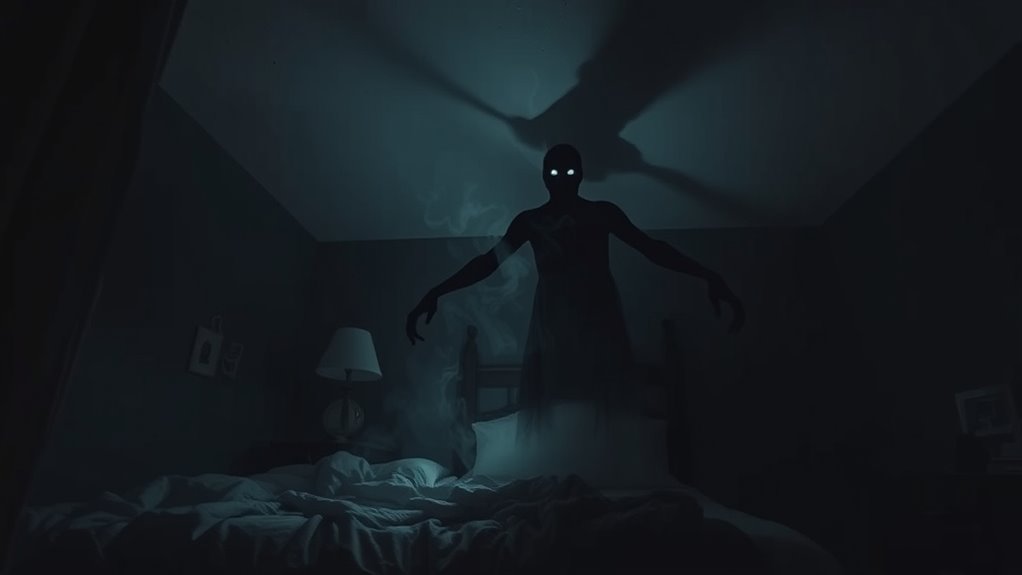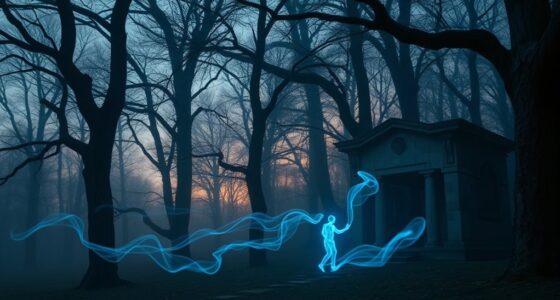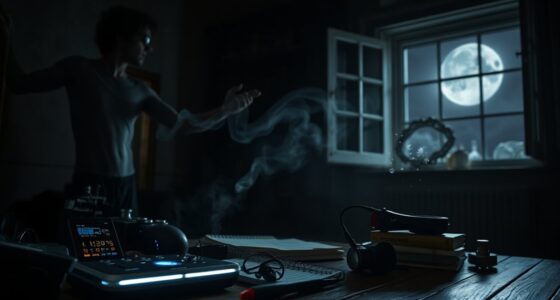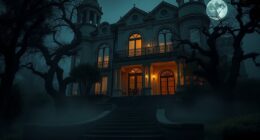Night terrors are intense non-REM sleep episodes that involve fear, agitation, and confusion, often mistaken for sleep paralysis or paranormal activity. Unlike sleep paralysis, you typically can move during night terrors, but both involve disrupted sleep cycles. Night terrors aren’t supernatural—they result from physiological changes in your brain during sleep, especially during stress or irregular schedules. Understanding these causes can help you see them as natural processes. If you’re curious, you’ll discover more about what really triggers these episodes.
Key Takeaways
- Night terrors occur during non-REM sleep, involving physical agitation and fear, unlike sleep paralysis, which involves paralysis and hallucinations.
- They are caused by disruptions in sleep cycle transitions, not supernatural or paranormal forces.
- Sleep paralysis involves an inability to move and vivid hallucinations during sleep-wake transitions, distinct from night terrors’ intense fear episodes.
- Night terrors are physiological sleep phenomena rooted in brain activity, not signs of paranormal activity or supernatural influence.
- Understanding sleep cycle dynamics and emotional processing clarifies that night terrors are normal sleep events, not paranormal experiences.
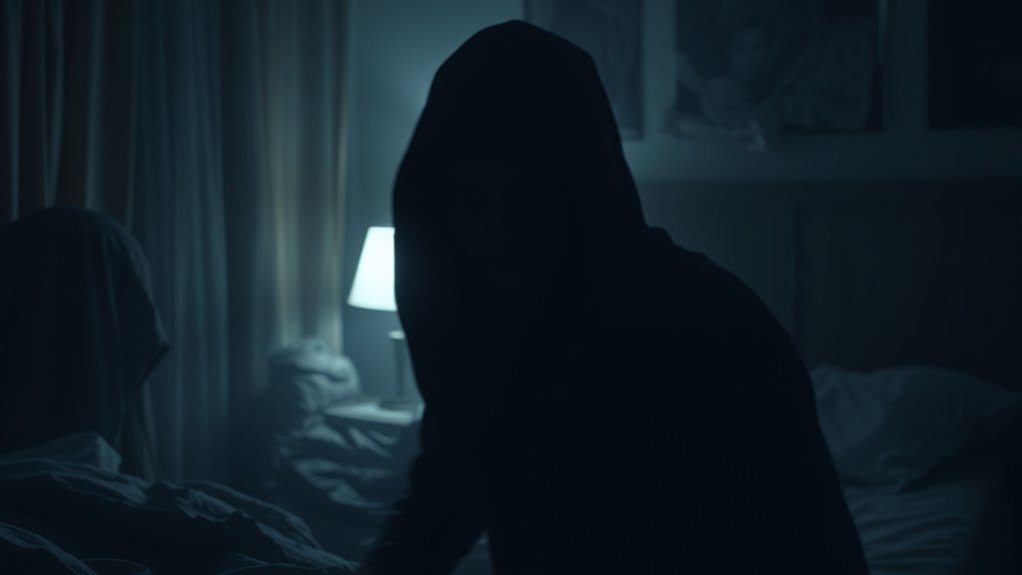
Have you ever woken up suddenly during the night feeling terrified, with no idea what caused it? That jarring moment might seem random, but it could be linked to what’s happening deep within your sleep cycle. Night terrors are often misunderstood—some think they’re just bad dreams or sleep paralysis, while others wonder if there’s something more paranormal at play. To understand them, you need to look at sleep cycle dynamics and how dream symbolism influences your subconscious during these episodes.
During a typical sleep cycle, you shift through stages of light sleep, deep sleep, and REM sleep. Night terrors usually occur during non-REM sleep, specifically in the early part of the night when your body is in a state of heightened arousal. This stage is different from vivid dreaming, which happens during REM sleep. When a night terror hits, your brain is in a unique state that can amplify feelings of fear and helplessness. You might thrash, scream, or even sit up, but you’re often not fully awake. This chaotic interplay between sleep stages can distort dream symbolism, making images or sensations seem much more terrifying than they would be in a normal dream.
Night terrors occur during non-REM sleep, amplifying fear and distorting dream symbolism without full awakening.
Understanding dream symbolism helps clarify why these episodes feel so intense. During a night terror, your mind might interpret subconscious fears or unresolved emotions as symbols of danger or threat. These symbols might be rooted in everyday stress, trauma, or even childhood memories. Because the brain processes emotions differently during non-REM sleep, the fear experienced in night terrors is less about a specific nightmare and more about a primal, instinctual response to perceived threats. The sleep cycle progression means your brain is in a heightened state of alertness, even as your body remains immobilized, which intensifies the feeling of terror. Additionally, research into sleep cycle dynamics reveals how disruptions can trigger such episodes. Recognizing the neurophysiological mechanisms involved can further demystify these occurrences. Moreover, understanding how brain wave activity shifts during these episodes can provide insights into their causes.
Many people wonder if these episodes are simply sleep paralysis or something paranormal. While sleep paralysis involves a temporary inability to move and often includes hallucinations, night terrors are different in that they usually involve extreme fear and physical agitation without conscious awareness. The scientific explanation points toward disruptions in sleep cycle dynamics, not supernatural activity. Recognizing that these episodes stem from natural physiological processes can ease fears and help you develop strategies to reduce their frequency, like maintaining a consistent sleep schedule and managing stress. Understanding the role of dream symbolism and sleep cycle dynamics reveals that night terrors are rooted in your brain’s complex way of processing emotions and maintaining sleep integrity, rather than anything paranormal.
Frequently Asked Questions
Can Night Terrors Occur in Adults or Only Children?
You might wonder if night terrors only happen in children, but they can occur in adults too. While childhood prevalence is higher, adult incidence is also significant, especially in stressful situations or with sleep disorders. In adults, night terrors often last longer and are more complex. So, whether you’re young or older, it’s possible to experience night terrors, and understanding their triggers can help manage them effectively.
Are Night Terrors Linked to Other Sleep Disorders?
Night terrors can be linked to other sleep disorders, especially if you experience sleep deprivation or high stress levels. When your sleep is disrupted or you struggle with stress management, your chances of having night terrors increase. These factors disturb your sleep cycle, making episodes more frequent. Managing stress and ensuring proper sleep hygiene can help reduce the occurrence of night terrors and improve your overall sleep quality.
How Can I Differentiate Between Night Terrors and Sleep Paralysis?
Think of night terrors and sleep paralysis as two different storms in your sleep. Night terror symptoms often include intense fear, screaming, and thrashing, usually during deep sleep. Sleep paralysis signs involve being unable to move or speak while waking up or falling asleep, sometimes with hallucinations. To tell them apart, note if you’re terrified and thrash or if you’re mostly immobilized with unsettling visions.
Do Night Terrors Have Long-Term Psychological Effects?
Night terrors can have lasting psychological effects, especially if they’re frequent or severe. You might experience increased anxiety, fear of sleeping, or emotional resilience issues over time. While many recover fully, some may develop ongoing psychological impacts like stress or sleep disturbances. It’s essential to address night terrors early, seek support if needed, and work on strengthening emotional resilience to minimize long-term effects.
Are There Effective Treatments or Cures for Night Terrors?
You might wonder if there’s an effective treatment for night terrors. Behavioral therapy can help identify stress triggers and improve sleep habits, reducing episodes. Medication options, like antidepressants or sedatives, may be prescribed for severe cases. It’s important to consult a healthcare professional to create a personalized plan. With proper treatment, you can often manage night terrors effectively and improve your overall sleep quality.
Conclusion
While night terrors might feel terrifyingly real, they’re rooted in your brain’s overactive fear responses, not paranormal forces. Unlike sleep paralysis, which leaves you aware yet immobilized, night terrors often cause intense screams and confusion, blurring the line between nightmare and reality. This contrast reminds you that what seems supernatural is often a natural, if unsettling, part of your mind’s complex workings. Embracing that truth can turn fear into understanding, transforming nightmares into mere illusions of the night.
